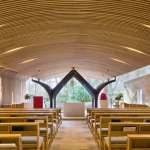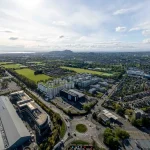Mansfield Traquair Centre Edinburgh building architect, Mansfield Place Broughton Project Images, Design
Mansfield Traquair Centre
Catholic Apostolic Church, Mansfield Place, Broughton, Edinburgh, Scotland
post updated 20 September 2024
Original building by Sir Robert Rowand Anderson – refurbished by Simpson & Brown Architects
Mansfield Traquair Centre, Mansfield Place, Broughton, Edinburgh, Scotland
Date of renewal: 2003
Simpson & Brown Architects
No larger photo, apologies:
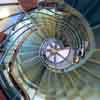
photo from Mansfield Traquair Centre 2003
Mansfield Traquair Centre Edinburgh Building
The Catholic Apostolic Church at Mansfield Place in Edinburgh is an early architectural masterpiece of Robert Rowand Anderson, Scotland’s premier architect of the late 19th century. The A-listed former Neo-Norman church of 1872 is a key building in the New Town of Edinburgh. The Mansfield Traquair Centre contains a vast mural painting cycle by Phoebe Anna Traquair, a leading member of the Arts and Crafts movement in Britain in the 1890s. The Herculean labour by the artist, the brilliant colour and the soaring space have led to the building being called ‘Edinburgh’s Sistine Chapel’. The former Church is also of considerable historic importance as a record of 19th century religious thought.
The Catholic Apostolic Church ceased worship in the church in 1958, since when the building suffered from lack of maintenance and the murals from water ingress. Mansfield Traquair Trust was set up in 1993, following growing awareness of the importance of the work of Phoebe Anna Traquair and the threat to the murals combined with local concern over proposals for various uses unsympathetic to the building and detrimental to the amenity of the area. After a five-year struggle, the Mansfield Traquair Trust managed to purchase the Church building in 1998, since when the fabric of the building has been repaired and the under-building converted into new headquarters for the Scottish Council for Voluntary Organisations.
The architects for the Church restoration were Simpson & Brown. The key to the rescue of the Mansfield Traquair Centre was the creation of substantial office space in the under-building. This gave the building a viable use. Two floors of offices were fitted into the space beneath the nave with ancillary accommodation below the chancel and in the attached clergy house. This considerable enabling development was contained within the envelope of the church building yet kept the main architectural spaces and the view of the Traquair murals unencumbered. The only alteration in the upper floor was a new floor laid on top of the original floor. This preserves the original floor and provides underfloor heating and cabling needed for a flexible multi-function space.
No larger photos, apologies:
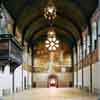
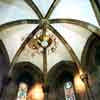
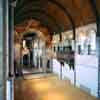
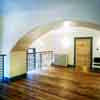
Photo from Mansfield Traquair Centre 2003
The new use would only work if new circulation could be created within the building. Even the widest original stair at the Centre does not allow two people to pass. The answer was to create a new stair sunk through the floor of the circular baptistery and to install a passenger lift in the space between the baptistery and the narthex. The new stair is linked to the two floors of offices by foyers created below the narthex. The main Mansfield Traquair Centre funders were the Heritage Lottery Fund, Historic Scotland and the City of Edinburgh Council.
Following the completion of the building contract, Mansfield Traquair Trust is now tackling the restoration of the murals. The work is being carried out by two Historic Scotland structural paintings conservators assisted by conservation interns. Thus, right from the start, the restoration of the Traquair murals provides a significant opportunity for the training of mural conservators. The principal funder for the restoration of the Mansfield Traquair Centre murals is Historic Scotland. After this painstaking work, which it is estimated will take over two years and cost over £500,000, the murals will once again be ‘scintillating and glowing like a jewelled crown’- as they were described when first completed a century ago.
The Mansfield Traquair Centre is regularly open to the public free-of-charge.
Restoration work costing £600k has commenced on the Mansfield Traquair murals decorating the Mansfield Traquair Centre, dubbed Edinburgh’s Sistine Chapel. The 100-year-old murals occupy 500sqm of space but have suffered water damage.
The centre was built in 1872 for members of the Catholic Apostolic Church; the congregation moved out in 1956. The Mansfield Traquair Trust bought the property in 1998, converting it into headquarters for the Scottish Council for Voluntary Organisations.
Mansfield Traquair Centre: Awards
This Catholic Apostolic Church building in Broughton, Edinburgh, Scotland, received a Civic Trust Awards Commendation 2004: praised for “bringing a notable social, cultural or economic benefit to their communities”.
The Mansfield Traquair Centre also received the Bronze Medal at the EAA Annual Awards for Architecture 2002.
Mansfield Traquair Centre ceased to be a church in 1958. The churchbuilders apparently believed that the world was going to end so they intended that the building would one day become useless.
Other featured former Edinburgh Churches include Tron Kirk
Scottish Capital Building Designs
Contemporary Scottish Capital Property Designs – recent architectural selection below:
1 Broughton Market short term let apartments
Edinburgh Buildings by Simpson & Brown Architects
Featured Edinburgh Buildings with involvement by Simpson & Brown Architects:
Rosslyn Chapel, Midlothian
Scottish Seabird Centre, North Berwick
St Ninian’s Manse, Leith
Mavisbank House, Midlothian
Buildings / photos for the Mansfield Traquair Centre Edinburgh building refurbished by Simpson & Brown Architects page welcome .
